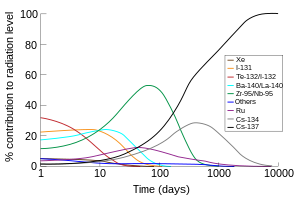
Back نظائر اليود Arabic Isòtops del iode Catalan Izotopy jodu Czech Йод изотопĕсем CV Izotopoj de jodo Esperanto Anexo:Isótopos de yodo Spanish ایزوتوپهای ید Persian Isotopes de l'iode French A jód izotópjai Hungarian Isotop iodin ID
This article needs additional citations for verification. (May 2018) |
| ||||||||||||||||||||||||||||||||||||||||||||||
| Standard atomic weight Ar°(I) | ||||||||||||||||||||||||||||||||||||||||||||||
|---|---|---|---|---|---|---|---|---|---|---|---|---|---|---|---|---|---|---|---|---|---|---|---|---|---|---|---|---|---|---|---|---|---|---|---|---|---|---|---|---|---|---|---|---|---|---|
There are 37 known isotopes of iodine (53I) from 108I to 144I; all undergo radioactive decay except 127I, which is stable. Iodine is thus a monoisotopic element.
Its longest-lived radioactive isotope, 129I, has a half-life of 15.7 million years, which is far too short for it to exist as a primordial nuclide. Cosmogenic sources of 129I produce very tiny quantities of it that are too small to affect atomic weight measurements; iodine is thus also a mononuclidic element—one that is found in nature only as a single nuclide. Most 129I derived radioactivity on Earth is man-made, an unwanted long-lived byproduct of early nuclear tests and nuclear fission accidents.
All other iodine radioisotopes have half-lives less than 60 days, and four of these are used as tracers and therapeutic agents in medicine. These are 123I, 124I, 125I, and 131I. All industrial production of radioactive iodine isotopes involves these four useful radionuclides.
The isotope 135I has a half-life less than seven hours, which is too short to be used in biology. Unavoidable in situ production of this isotope is important in nuclear reactor control, as it decays to 135Xe, the most powerful known neutron absorber, and the nuclide responsible for the so-called iodine pit phenomenon.
In addition to commercial production, 131I (half-life 8 days) is one of the common radioactive fission products of nuclear fission, and is thus produced inadvertently in very large amounts inside nuclear reactors. Due to its volatility, short half-life, and high abundance in fission products, 131I (along with the short-lived iodine isotope 132I, which is produced from the decay of 132Te with a half-life of 3 days) is responsible for the largest part of radioactive contamination during the first week after accidental environmental contamination from the radioactive waste from a nuclear power plant. Thus highly dosed iodine supplements (usually potassium iodide) are given to the populace after nuclear accidents or explosions (and in some cases prior to any such incident as a civil defense mechanism) to reduce the uptake of radioactive iodine compounds by the thyroid before the highly radioactive isotopes have had time to decay.

- ^ "Standard Atomic Weights: Iodine". CIAAW. 1985.
- ^ Prohaska, Thomas; Irrgeher, Johanna; Benefield, Jacqueline; Böhlke, John K.; Chesson, Lesley A.; Coplen, Tyler B.; Ding, Tiping; Dunn, Philip J. H.; Gröning, Manfred; Holden, Norman E.; Meijer, Harro A. J. (2022-05-04). "Standard atomic weights of the elements 2021 (IUPAC Technical Report)". Pure and Applied Chemistry. doi:10.1515/pac-2019-0603. ISSN 1365-3075.
- ^ "Nuclear Data Evaluation Lab". Archived from the original on 2007-01-21. Retrieved 2009-05-13.
© MMXXIII Rich X Search. We shall prevail. All rights reserved. Rich X Search